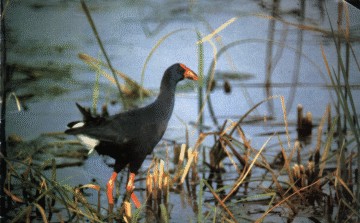|
|
|
|

| The
dunes, the sand banks, the canals and the marshes run along the undefined
line of the horizon, guaranteeing the Formosa Estuary in the Algarve its
role as one of the most important points in the network of wetlands that
links Europe and sub-Saharan Africa.
Text provided by the Portuguese Tourist Office (with minimal corrections) A wintering
ground for many migratory birds. The Estuary has an enormous variety
of natural habitats and biotopes that provide refuge, feeding or breeding
areas for an infinite number of live organisms, from zooplankton to fish,
crustaceans, amphibians, reptiles and eventually mammals, such as the otter,
all depending on the preservation of the Estuary for their survival.
Among
these varieties are the common caiman or the sultan chicken, simultaneously
one of the most representative and most endangered inhabitants of this
area. Chosen as the symbol of the Formosa Estuary Natural Park,
the sultan chicken is a large bird with bluish feathers and bright red
feet and beak. It is very rare and it is estimated that the population
does not exceed twenty individual birds.
The flora varies from the sandy zones (armenias, sea thistles, sand cactuses) to the marches where the existence of some species depends on their resistance to submersion by seawater. Of this immense variety, the Algarve limonium, which constitutes a local endemic species, is particularly important. Phoenicians, Romans, Arabs and Christians developed the land, leaving remains that can still be seen. Fuzeta, an ancient village that lived on tuna fishing, the crossroads of the Olhao streets with their moorish terraces, the 37 churches of Tavira and the old Arab principality that gave rise to Faro, are good examples of this. The Natural Park is also responsible for preserving this cultural heritage and this has accounted for the recovery of the tide mill at Marim, a traditional tuna fishing boat and some Roman salting tanks. Together with these initiatives, the Natural Park has also started up a project for breeding the native water dogs, that had become almost extinct. It has also built a recuperation centre for birds of prey. |
|
|
|
|||||
|
|
|
|||||
|
|
|
|||||
|
|
Return to Parks index